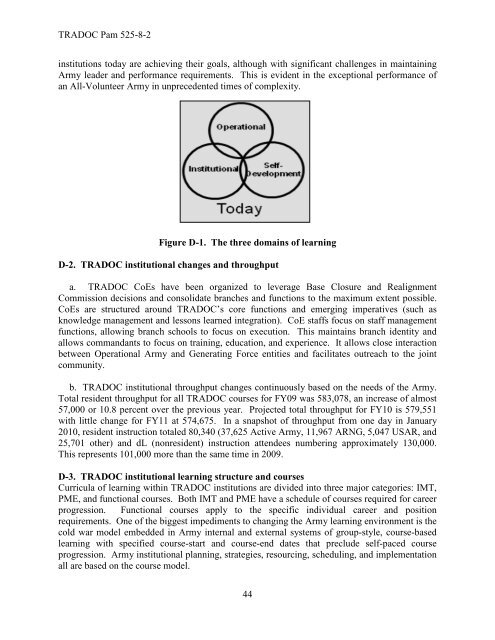K3zgZ
K3zgZ
K3zgZ
You also want an ePaper? Increase the reach of your titles
YUMPU automatically turns print PDFs into web optimized ePapers that Google loves.
TRADOC Pam 525-8-2<br />
institutions today are achieving their goals, although with significant challenges in maintaining<br />
Army leader and performance requirements. This is evident in the exceptional performance of<br />
an All-Volunteer Army in unprecedented times of complexity.<br />
Figure D-1. The three domains of learning<br />
D-2. TRADOC institutional changes and throughput<br />
a. TRADOC CoEs have been organized to leverage Base Closure and Realignment<br />
Commission decisions and consolidate branches and functions to the maximum extent possible.<br />
CoEs are structured around TRADOC’s core functions and emerging imperatives (such as<br />
knowledge management and lessons learned integration). CoE staffs focus on staff management<br />
functions, allowing branch schools to focus on execution. This maintains branch identity and<br />
allows commandants to focus on training, education, and experience. It allows close interaction<br />
between Operational Army and Generating Force entities and facilitates outreach to the joint<br />
community.<br />
b. TRADOC institutional throughput changes continuously based on the needs of the Army.<br />
Total resident throughput for all TRADOC courses for FY09 was 583,078, an increase of almost<br />
57,000 or 10.8 percent over the previous year. Projected total throughput for FY10 is 579,551<br />
with little change for FY11 at 574,675. In a snapshot of throughput from one day in January<br />
2010, resident instruction totaled 80,340 (37,625 Active Army, 11,967 ARNG, 5,047 USAR, and<br />
25,701 other) and dL (nonresident) instruction attendees numbering approximately 130,000.<br />
This represents 101,000 more than the same time in 2009.<br />
D-3. TRADOC institutional learning structure and courses<br />
Curricula of learning within TRADOC institutions are divided into three major categories: IMT,<br />
PME, and functional courses. Both IMT and PME have a schedule of courses required for career<br />
progression. Functional courses apply to the specific individual career and position<br />
requirements. One of the biggest impediments to changing the Army learning environment is the<br />
cold war model embedded in Army internal and external systems of group-style, course-based<br />
learning with specified course-start and course-end dates that preclude self-paced course<br />
progression. Army institutional planning, strategies, resourcing, scheduling, and implementation<br />
all are based on the course model.<br />
44




